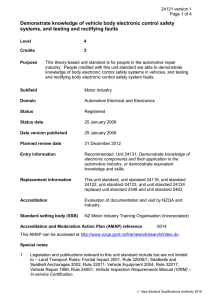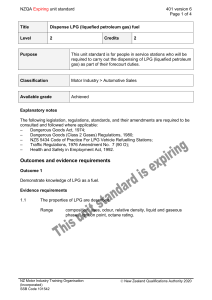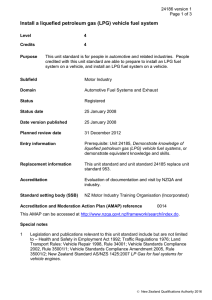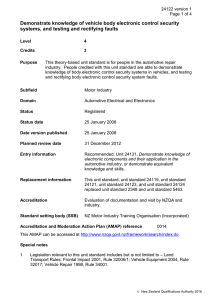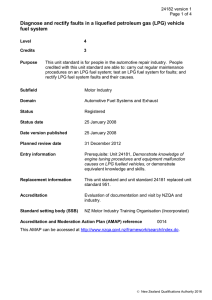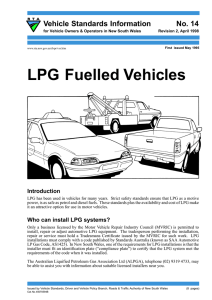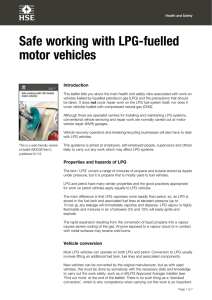Demonstrate knowledge of engine tuning procedures and equipment
advertisement
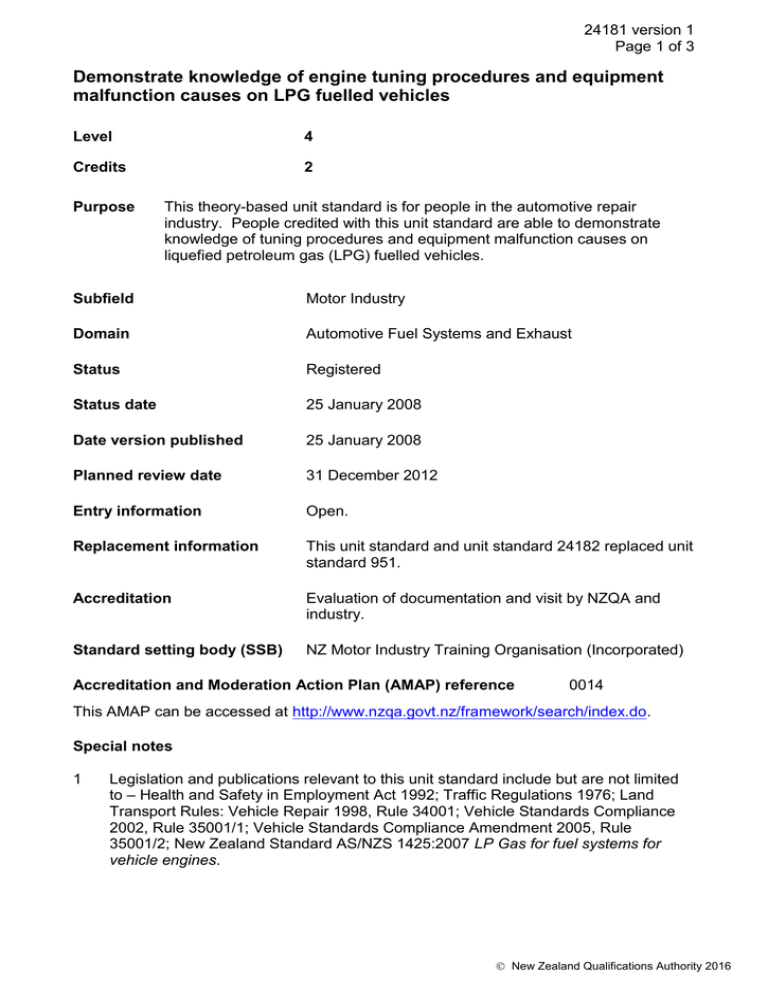
24181 version 1 Page 1 of 3 Demonstrate knowledge of engine tuning procedures and equipment malfunction causes on LPG fuelled vehicles Level 4 Credits 2 Purpose This theory-based unit standard is for people in the automotive repair industry. People credited with this unit standard are able to demonstrate knowledge of tuning procedures and equipment malfunction causes on liquefied petroleum gas (LPG) fuelled vehicles. Subfield Motor Industry Domain Automotive Fuel Systems and Exhaust Status Registered Status date 25 January 2008 Date version published 25 January 2008 Planned review date 31 December 2012 Entry information Open. Replacement information This unit standard and unit standard 24182 replaced unit standard 951. Accreditation Evaluation of documentation and visit by NZQA and industry. Standard setting body (SSB) NZ Motor Industry Training Organisation (Incorporated) Accreditation and Moderation Action Plan (AMAP) reference 0014 This AMAP can be accessed at http://www.nzqa.govt.nz/framework/search/index.do. Special notes 1 Legislation and publications relevant to this unit standard include but are not limited to – Health and Safety in Employment Act 1992; Traffic Regulations 1976; Land Transport Rules: Vehicle Repair 1998, Rule 34001; Vehicle Standards Compliance 2002, Rule 35001/1; Vehicle Standards Compliance Amendment 2005, Rule 35001/2; New Zealand Standard AS/NZS 1425:2007 LP Gas for fuel systems for vehicle engines. New Zealand Qualifications Authority 2016 24181 version 1 Page 2 of 3 2 Land Transport Rules are produced for the Minister of Transport by Land Transport New Zealand. These rules are available online at http://www.landtransport.govt.nz/rules/. New Zealand Standards are available from Standards New Zealand, Private Bag 2439, Wellington; phone 04 498 5990; or website http://www.standards.co.nz. 3 Definitions Company requirements refer to instructions to staff on policy and procedures which are documented in memo or manual format and are available in the workplace. These requirements include but are not limited to – company specifications and procedures, work instructions, manufacturer specifications, product quality specifications, and legislative requirements. LPG equipment manufacturer instructions refer to specifications and instructions provided by the equipment manufacturer for the correct installation and operation of the LPG component(s) or system(s) provided by that manufacturer. Elements and performance criteria Element 1 Demonstrate knowledge of tuning procedures and equipment malfunction causes on LPG fuelled vehicles. Performance criteria 1.1 Problems that may affect engine operation following the fitment of conversion systems are identified in accordance with LPG equipment manufacturer instructions. Range 1.2 Problems that may occur with LPG components in service are described in accordance with LPG equipment manufacturer instructions. Range 1.3 mechanical and electrical faults, lack of servicing, external problems affecting performance. The procedure to perform on-road acceleration tests is described in accordance with company requirements. Range 1.4 malfunctions related to fuel supply and gas usage. hesitation, misfiring, flat spots, overall performance. The use of a rolling chassis dynamometer and an infra-red exhaust gas analyser for carrying out adjustment and test procedures on an engine operating on dual fuel is explained in accordance with LPG equipment manufacturer instructions. Range engine under load conditions throughout revolutions per minute (RPM) range. New Zealand Qualifications Authority 2016 24181 version 1 Page 3 of 3 1.5 The modification requirements required for vehicles to run on dedicated LPG are explained in accordance with LPG equipment manufacturer instructions. Range 1.6 Legislative requirements when carrying out repairs and maintenance to vehicles equipped with LPG fuels system are described. Range 1.7 removal of existing petrol system components, fitting of gas components, alterations to compression ratio, ignition components, ignition timing, exhaust emission controls, air intake systems, valve and valve seat modifications, turbocharging, intercooling. AS/NZS 1425, Traffic Regulations, Land Transport Rules (Vehicle Repair, Vehicle Standards Compliance). Procedures to maintain an LPG fuel system are described in accordance with service information and legislative requirements. Range filter cleaning, regulator draining, air filter, leak detection, security of components, hose condition, mixer attachment. Please note Providers must be accredited by NZQA, or an inter-institutional body with delegated authority for quality assurance, before they can report credits from assessment against unit standards or deliver courses of study leading to that assessment. Industry Training Organisations must be accredited by NZQA before they can register credits from assessment against unit standards. Accredited providers and Industry Training Organisations assessing against unit standards must engage with the moderation system that applies to those standards. Accreditation requirements and an outline of the moderation system that applies to this standard are outlined in the Accreditation and Moderation Action Plan (AMAP). The AMAP also includes useful information about special requirements for organisations wishing to develop education and training programmes, such as minimum qualifications for tutors and assessors, and special resource requirements. Comments on this unit standard Please contact the NZ Motor Industry Training Organisation (Incorporated) info@mito.org.nz if you wish to suggest changes to the content of this unit standard. New Zealand Qualifications Authority 2016


